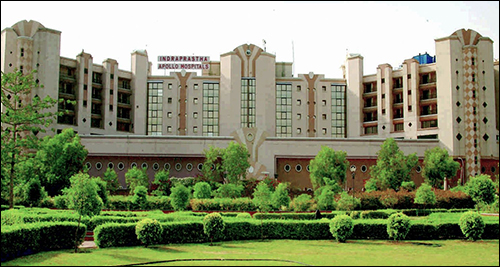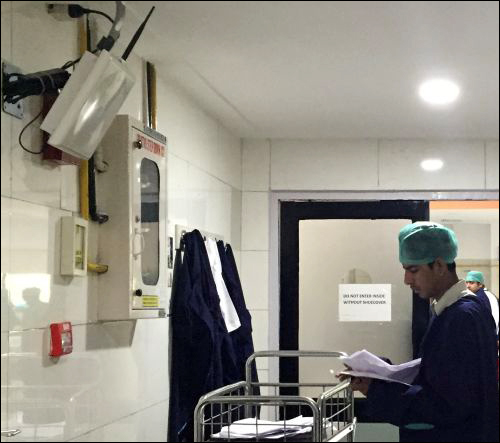Indraprastha Apollo Hospitals‘ facility in Delhi, India, is using a passive ultrahigh-frequency (UHF) RFID system to track the movements of assets within its intensive care units (ICUs). The asset-management solution, provided by Dolphin RFID, enables the hospital to identify in which of its ICU units a given piece of equipment is located. The next step will be to employ RFID to help personnel identify when equipment was last serviced, based on data inputted during the maintenance process via a handheld reader. That phase of the installation is slated to take place during the second half of this year.
Indraprastha Medical Corp. (IMC)—Indraprastha Apollo Hospitals’ parent organization—encompasses a total of 10,000 patient beds at 64 different hospitals, as well as 2,200 pharmacies and 100 primary-care and diagnostic clinics, across nine countries. Indraprastha Apollo Hospitals’ Delhi facility is the city’s second largest hospital in terms of beds (it has 795) and physical size (600,000 square feet of facility space spread across a 15-acre campus). It offers 52 specialties and more ICU beds than any private hospital in India. The ICUs consist of eight individual specialties, and the hospital sought greater visibility into its equipment so that if employees needed a specific item, such as a cart or pump, it could be easily accessed. In some cases, emergency equipment for pediatric, heart and other ICU services could be moved from one ICU specialty area to another, and a patient’s care could thus be delayed while staff members searched for it.

“When you need medical equipment… you need to locate it fast,” says Ashoke Chakrabartty, Indraprastha Medical Corp.’s senior general manager of biomedical engineering. “We planned to use RFID to track and locate critical medical devices.” Chakrabartty, who is responsible for all technical equipment procurement for IMC’s hospitals, had difficulty finding a local solution provider that could meet the hospital’s needs. “Using RFID with medical devices is a challenge in this country,” he explains. “Not many players are conversant with this type of application.”
Chakrabartty preferred not to deploy active RFID tags that would utilize the facility’s existing Wi-Fi network, he says, since the use of hundreds or potentially thousands of Wi-Fi tags would create a strain on the network. What’s more, he adds, the cost of active RFID tags was simply too expensive when dealing with very large numbers of assets.
Apollo opted for a Dolphin solution leveraging passive UHF tags to track equipment, since such tags would not tax the existing Wi-Fi infrastructure. The hospital installed four reader portals, each consisting of a ThingMagic Astra-EX reader, which comes with an integrated antenna. The hospital, however, did not want to run cabling through its ICU area to connect the readers to the server, says Suresh Sawhney, Dolphin RFID’s president and CEO. Therefore, he notes, it opted to use a Wi-Fi radio installed by Dolphin, thereby providing a compromise in Wi-Fi use.
Once the readers were installed, the hospital noticed drops in Wi-Fi coverage and worked with Dolphin to resolve the issue. “Even a small drop in network throughput,” Chakrabartty states, “and our readers would disconnect and we had to restart our readers each time.” The problem has been resolved for now, he says, but in the long run, as the RFID deployment expands to other parts of the facility, the hospital plans to augment its Wi-Fi network by creating a separate high-speed Wi-Fi network to sustain data transmission from readers to the server.
The installation had begun earlier this year with a proof-of-concept trial at two of the hospital’s eight intensive care units and, after about four weeks of trials, the installation of reader portals at the additional ICUs. A second trial will now be underway at another Apollo facility—the Apollo Gleneagles Hospitals, in Kolkata (Calcutta)—later this month.
Attached to approximately 300 medical devices is an on-metal passive UHF tag manufactured by a third party for Dolphin RFID. The unique ID number encoded to each tag’s memory is linked to data regarding the device to which it is attached, including its description. As the item’s tag ID is captured by one of the four readers in the ICUs, Dolphin’s Edge Wizard middleware interprets the collected read data, pairs the item with its location based on the reader’s ID and forwards that information to the hospital’s own management software.
A staff member seeking a particular piece of equipment can then access the Edge Wizard software to view that item’s last detected location, and thereby determine in which zone it is located—for example, in the pediatric ICU. The technology is saving staff members time, though the hospital has not yet conducted time studies to measure the exact savings.

The system can also be used with Dolphin’s Android-based handheld readers, which the hospital plans to adopt in the “near future,” Chakrabartty says. Staff members could report to the zone in which the software last detected a tagged item, and then use the handheld reader, running Dolphin’s Android-based firmware, to locate that item via a Geiger counter function. A worker using one of the handhelds could view alerts and status updates on the device’s screen that would indicate, for instance, which items are due for preventative maintenance in the zone in which that individual is located.
Additionally, maintenance personnel can service a piece of equipment and use the handheld to read its tag. They could then input the services they are providing, and that information would be stored in the Edge Wizard software.
To date, Chakrabartty says, the RFID system has been “very helpful for the asset tracking.” He adds that he hopes the technology will be especially useful “for timely preventive maintenance of medical equipment.”
“If our first phase of the project—using the existing portal readers to track medical equipment in the ICU—goes well,” Chakrabartty says, “we will plan to implement [the system] in the entire hospital.”


